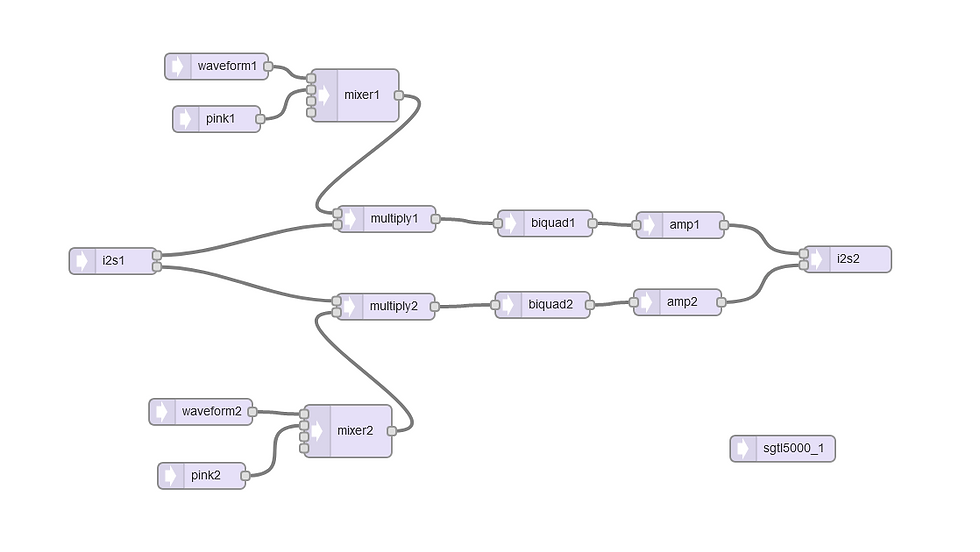Ring Mod
- tom
- May 21, 2021
- 3 min read
Updated: Jul 2, 2021
Stereo effect using the waveform object to create a selection of waveforms to ring modulate with the guitar input signal. Ring modulating is done with the multiply object. There's a variable low pass filter at the output and a bit of make-up gain after it.

I didn't include the variable triangle waveform or the arbitrary waveform, opting instead to ring modulate the guitar signal with pink noise, which sounds errr.... These are the waveforms available, from counter-clockwise to clockwise on pot A0:
WAVEFORM_SINE
WAVEFORM_SAWTOOTH
WAVEFORM_SAWTOOTH_REVERSE
WAVEFORM_SQUARE
WAVEFORM_TRIANGLE
WAVEFORM_PULSE
WAVEFORM_SAMPLE_HOLD
PINK NOISE
A0 = waveform select, A1 = waveform frequency, A2 = low pass filter.
I haven't used pot A3, the toggle or the footswitch.
#define LED 3
#include <Bounce.h>
#include <Audio.h>
#include <Wire.h>
#include <SPI.h>
#include <SD.h>
#include <SerialFlash.h>
// GUItool: begin automatically generated code
AudioInputI2S i2s1; //xy=328,397
AudioSynthWaveform waveform2; //xy=428,569
AudioSynthNoisePink pink2; //xy=429,642
AudioSynthWaveform waveform1; //xy=446,175
AudioSynthNoisePink pink1; //xy=446,235
AudioMixer4 mixer2; //xy=596,591
AudioMixer4 mixer1; //xy=604,208
AudioEffectMultiply multiply2; //xy=639,449
AudioEffectMultiply multiply1; //xy=640,349
AudioFilterBiquad biquad2; //xy=818,447
AudioFilterBiquad biquad1; //xy=821,354
AudioAmplifier amp2; //xy=972,444
AudioAmplifier amp1; //xy=975,356
AudioOutputI2S i2s2; //xy=1166,395
AudioConnection patchCord1(i2s1, 0, multiply1, 1);
AudioConnection patchCord2(i2s1, 1, multiply2, 0);
AudioConnection patchCord3(waveform2, 0, mixer2, 0);
AudioConnection patchCord4(pink2, 0, mixer2, 1);
AudioConnection patchCord5(waveform1, 0, mixer1, 0);
AudioConnection patchCord6(pink1, 0, mixer1, 1);
AudioConnection patchCord7(mixer2, 0, multiply2, 1);
AudioConnection patchCord8(mixer1, 0, multiply1, 0);
AudioConnection patchCord9(multiply2, biquad2);
AudioConnection patchCord10(multiply1, biquad1);
AudioConnection patchCord11(biquad2, amp2);
AudioConnection patchCord12(biquad1, amp1);
AudioConnection patchCord13(amp2, 0, i2s2, 1);
AudioConnection patchCord14(amp1, 0, i2s2, 0);
AudioControlSGTL5000 sgtl5000_1; //xy=1092,611
// GUItool: end automatically generated code
Bounce footswitch = Bounce(0, 50); // debounce the footswitch
Bounce D1 = Bounce(1, 50); // debounce the toggle switch
Bounce D2 = Bounce(2, 50); // " " " " " " " " "
// check the toggle position
bool right;
bool middle;
bool left;
void checkToggle () { // our function to check toggle position
D1.update(); D2.update(); // check digital inputs connected to toggle
if(digitalRead(1) && !digitalRead(2)) {right = 1; middle = 0; left = 0;} // toggle is right
if(digitalRead(1) && digitalRead(2)) {right = 0; middle = 1; left = 0;} // toggle is in the middle
if(!digitalRead(1) && digitalRead(2)) {right = 0; middle = 0; left = 1;} // toggle is left
}
byte wavepot;
byte waveform;
int pitch;
int lpf;
void setup() {
AudioMemory(40); // the "40" will vary depending on your effect, eg. a delay effect will require more memory .... (HOW MUCH?)
sgtl5000_1.enable(); // this turns on the SGTL5000, which is the audio codec on the audio board
sgtl5000_1.volume(1); // this sets the output volume (it can be between 0 and 1)
sgtl5000_1.inputSelect(AUDIO_INPUT_LINEIN); // selects the audio input, we always use Line In
analogReadResolution(12); // configure the pots to give 12 bit readings
pinMode(0, INPUT_PULLUP); // internal pull-up resistor for footswitch
pinMode(1, INPUT_PULLUP); // internal pull-up resistor for toggle
pinMode(2, INPUT_PULLUP); // internal pull-up resistor for toggle
pinMode(3, OUTPUT); // pin 3 (the LED) is an output;
Serial.begin(9600); // initiate the serial monitor. USB is always 12 Mbit/sec
// waveform set up
waveform1.offset(0);
waveform2.offset(0);
pink1.amplitude(1);
pink2.amplitude(1);
// make up gain
amp1.gain(2);
amp2.gain(2);
}
void loop() {
// A0 = waveform
wavepot = analogRead(A0) >> 9;
if(wavepot == 0) waveform = WAVEFORM_SINE;
if(wavepot == 1) waveform = WAVEFORM_SAWTOOTH;
if(wavepot == 2) waveform = WAVEFORM_SAWTOOTH_REVERSE;
if(wavepot == 3) waveform = WAVEFORM_SQUARE;
if(wavepot == 4) waveform = WAVEFORM_TRIANGLE;
if(wavepot == 5) waveform = WAVEFORM_PULSE;
if(wavepot == 6) waveform = WAVEFORM_SAMPLE_HOLD;
if(wavepot == 7) { // pink noise
mixer1.gain(0, 0);
mixer1.gain(1, 1);
mixer2.gain(0, 0);
mixer2.gain(1, 1);
}
else {
mixer1.gain(0, 1);
mixer1.gain(1, 0);
mixer2.gain(0, 1);
mixer2.gain(1, 0);
}
// A1 = frequency
pitch = (analogRead(A1) << 1) + 1; // frequency is 1 to 8189
// set waveform
waveform1.begin(1, pitch, waveform);
waveform2.begin(1, pitch, waveform);
// A2 = low pass filter
lpf = analogRead(A2) + 1000;
biquad1.setLowpass(0, lpf, 0.8);
biquad2.setLowpass(0, lpf, 0.8);
}



















Comments